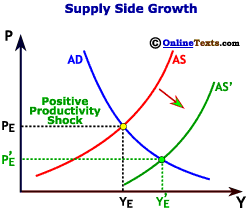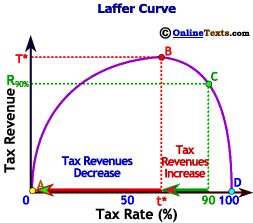By increasing taxes the government shifts the Aggregate Demand curve to the left.
The tax multiplier is given by the formula -MPC/(1-MPC).
|
|
Tool #2: Change in Taxes
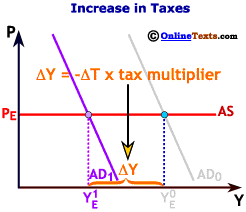
The government sets tax policy, which determines how much of the nation's gross income will be taxed. The U.S. income tax is a proportional tax in that a percentage of each person's income is taxed. The total amount of tax each person pays depends on her income. When the government raises taxes, more of a person's gross income goes to the government so she has less disposable income for personal use. Less disposable income leads to less consumption. An increase in taxes, therefore, shifts the Aggregate Demand curve to the left. Such a scenario is illustrated in the figure titled "Increase in Taxes."
In June 2001 President Bush pushed a $1.3 trillion tax cut through Congress. The full tax reduction of $1.3 trillion will be realized over a ten-year period; nevertheless, the change in taxes shifts the Aggregate Demand curve to the right. Part of the tax change gave a rebate of up to $600 to households. Hence, personal income and consumption increased. Why would President Bush enact such a policy? His motives may have been complicated including a desire to be elected, but part of the reason was to stimulate the economy to prevent the nation from slipping into recession. In other words, the President and his advisors sensed that the nation was slipping into a recessionary gap and he wanted to enact policy to reduce the probability of a recession occurring.
With the advantage of hindsight, the timing of the tax cut was ideal, even if one questions the wisdom of the tax cuts as a whole. The economy officially slipped into recession in March 2001; the tax cuts gave consumers additional disposable income over the next few months. Indeed, strong consumer spending was the major reason that the recession was relatively mild.
The Tax Multiplier
Tax changes are also subject to the output multiplier effect, but the process is slightly more complicated than that for a change in government expenditures. Unlike a change in government expenditures, a change in the tax rate impacts Aggregate Demand indirectly by first reducing disposable income, which then reduces consumption. Recall that disposable income is equal to national income (Y) less taxes (T) plus transfer payments (TR), or DI = Y - T + TR. If taxes rise, disposable income falls. The decline in disposable income reduces consumption, but not by the full amount of the income decline. When taxes rise, disposable income falls by the MPC times the change in disposable income because only a portion of the lost income would have been consumed. Let's work through an example.
Suppose that Mitch has a consumption function of the following form:
C = $100 + 0.8(DI)
and his disposable income goes from $1,000 to $900 per month because his taxes increase by $100 per month. At $1,000 Mitch's monthly consumption was
C = $100 + 0.8($1,000) = $900,
but with disposable income at $900, his monthly consumption falls to
C = $100 + 0.8($1,000-$100) = $820.
Mitch's consumption declined by $80, which is equal to the MPC (0.8) times the change in taxes ($100).
Recall that the multiplier effect is given by the formula

For an increase in taxes, the initial decrease in Aggregate Demand is not the amount of the tax change, but the MPC times the tax change, or

Because we are ultimately interested in the relationship between a change in output and a change in taxes, we rewrite the above equation as:

where -MPC/(1-MPC) is the tax multiplier. For example, if the MPC is 0.8, then the tax multiplier is -0.8/(1-0.8) = - 4. Note that the tax multiplier is smaller and has the opposite sign as the simple output multiplier. The smaller size is because the effect of a tax increase on Aggregate Demand is indirect. The opposite sign is because an increase in taxes decreases output. Conversely, a decrease in taxes increases output.
|

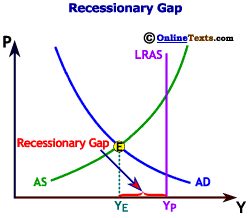
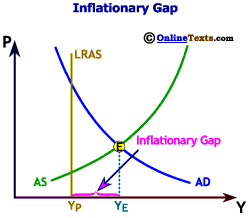
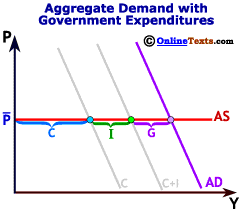
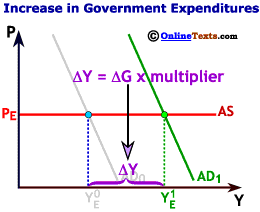




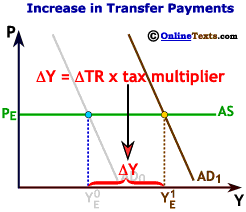
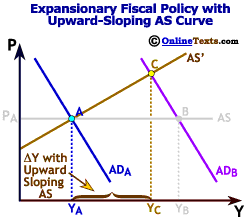 If the Aggregate Supply curve is upward sloping rather than horizontal (as we assume in the fixed-price model), then two things are different about fiscal policy:
If the Aggregate Supply curve is upward sloping rather than horizontal (as we assume in the fixed-price model), then two things are different about fiscal policy: